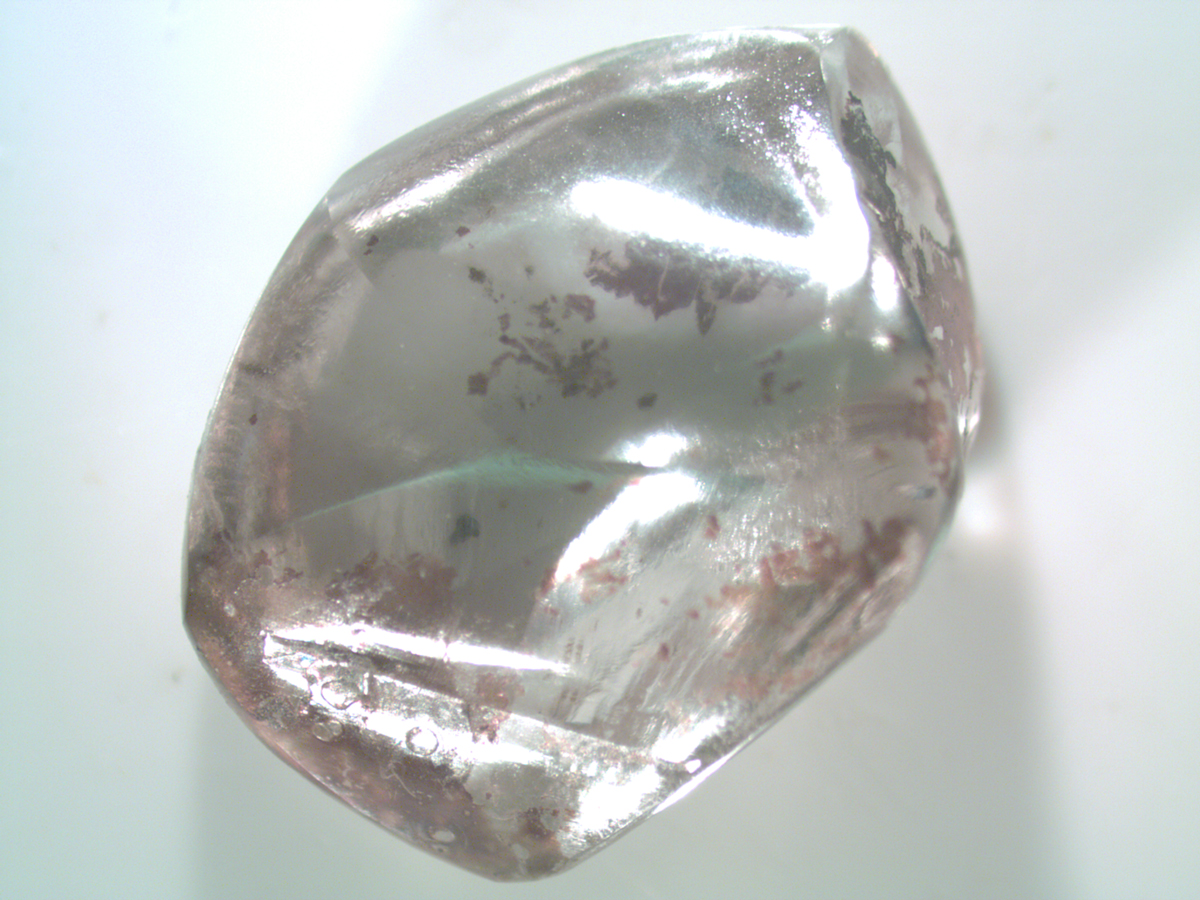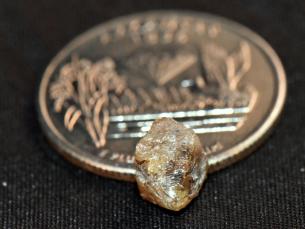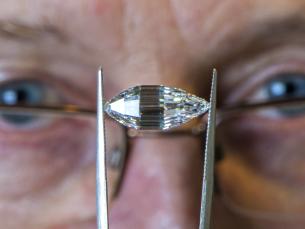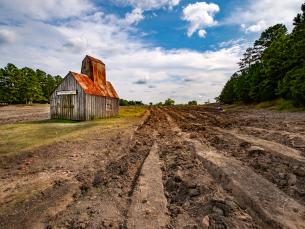Woman Finds 2.63-Carat Diamond at Crater of Diamonds State Park in Arkansas
(Murfreesboro, AR) - A 71-year-old retiree from Aurora, Colorado made the find of a lifetime this month at Arkansas’s Crater of Diamonds State Park, when she discovered an ice white diamond weighing nearly three carats.
According to the finder, who wishes to remain anonymous, she had been searching for about ten minutes with her husband, son, grandson, and granddaughter when she made the discovery. “I was using a rock to scrape the dirt but don’t know if I uncovered the diamond with it or not. It was just lying on the surface!” She found the gem about halfway between the East Drain and North Wash Pavilion in the park’s 37.5-acre diamond search area, the eroded surface of an ancient, diamond-bearing volcanic crater.
The Coloradan didn’t realize that she had picked up a diamond, and thought it might be a piece of glass. Fortunately, she gave the gem to her son to put in his pocket. The family continued searching for another hour before having their rocks and minerals identified at the park’s Diamond Discovery Center, where staff revealed that the Coloradan had found the largest diamond so far in 2018. Upon learning that she had found a large diamond, the finder said, “I didn’t know what to think. I was shocked!”

Park Interpreter Waymon Cox says, “About one out of every five diamonds registered by park visitors is found right on top of the ground, including many of the largest ever found at the Crater of Diamonds.” Park personnel plow the diamond search area periodically to loosen the soil and assist with natural erosion. Diamonds are a bit heavy for their size and lack static electricity, so dirt doesn’t stick to them. When rainfall uncovers larger diamonds and the sun comes out, they sparkle and are often easy to see.
According to Cox, “Like other rocks and minerals, no two diamonds are exactly alike. This white diamond is about the size of a pinto bean and is shaped somewhat like a fingernail. Several brownish, freckle-like marks along the surface give the gem a unique, one-of-a-kind appearance.”
Many visitors choose to name the diamonds they find at Crater of Diamonds State Park. This finder named her gem Lichtenfels, the name of her hometown in Germany and a word that means “a rock between two lights.” The finder’s son pointed out that she was standing between her grandchildren when she found the diamond. “She wouldn’t have come to the park if it weren’t for her grandkids,” he explained, “They’re her two points of light.”
As of this writing, 256 diamonds have been registered at Crater of Diamonds State Park so far in 2018, weighing a total of 49.64 carats. Five diamonds registered this year have weighed at least one carat each.
Quick Facts about Crater of Diamonds State Park
Diamonds come in all colors of the rainbow. The three most common colors found at Crater of Diamonds State Park are white, brown, and yellow, in that order.
In total, more than 75,000 diamonds have been unearthed at the Crater of Diamonds since the first diamonds were found here in 1906 by John Huddleston, a farmer who owned the land long before it became an Arkansas State Park in 1972. The largest diamond ever discovered in the United States was unearthed here in 1924 during an early mining operation. Named the Uncle Sam, this white diamond with a pink cast weighed 40.23 carats. Other notable diamonds found by visitors to the state park include the Amarillo Starlight, a 16.37-carat white diamond discovered in 1975, which ranks as the largest diamond ever found by a park visitor.
The second-largest find by a visitor is the Star of Shreveport, an 8.82-carat white gem unearthed in 1981. In 2011, a visitor from Colorado found an 8.66-carat white gem named the Illusion Diamond, which is the third-largest gem found at the park.
In June 2015, another visitor from Colorado discovered an 8.52-carat white diamond named the Esperanza, the fifth-largest diamond found by a visitor. In September 2015, celebrated diamond cutter Mike Botha cut the Esperanza into a 4.6-carat triolette shape during a public event in North Little Rock. The diamond was later graded colorless and internally flawless by the American Gem Society and valued at $500,000.
Another notable diamond from the Crater of Diamonds is the 1.09-carat D-flawless Strawn-Wagner Diamond. Discovered in 1990 by park visitor Shirley Strawn of Murfreesboro, this white gem weighed 3.03 carats in the rough before being cut to perfection in 1997 by the renowned diamond firm Lazare Kaplan International of New York. The gem was certified as perfect in the laboratory of the American Gem Society. It is on display in a special exhibit in the Crater of Diamonds State Park visitor center.
An additional gem from the Crater is the flawless 4.25-carat Kahn Canary diamond that was discovered at the park in 1977. This uncut, triangular-shape gem has been on exhibit at many cities around the U.S. and overseas. It was featured in an illustrious jewelry exhibition in Antwerp, Belgium, in 1997 that included precious stones from throughout the world including the Kremlin collection, the Vatican, Cartier, and Christies. In late 1997, the Kahn Canary was featured in another prestigious exhibition at the American Museum of Natural History in New York entitled “The Nature of Diamonds.” Former First Lady Hillary Clinton borrowed the Kahn Canary from its owner, Stan Kahn of Pine Bluff, Arkansas, and wore it in a special, Arkansas-inspired ring setting designed by Henry Dunay of New York as a special way to represent Arkansas’s diamond site at the galas celebrating both of Bill Clinton’s presidential inaugurals.
Crater of Diamonds State Park is located on Arkansas Highway 301 in Murfreesboro. It is one of 52 state parks administered by the State Parks Division of the Arkansas Department of Parks and Tourism.
About Arkansas State Parks
Arkansas state parks and museums cover 54,400 acres of forest, wetlands, fish and wildlife habitat, outdoor recreation facilities and unique historic and cultural resources. The system includes 1,100 buildings (including 183 historic structures), six National Historic Landmarks, a National Natural Landmark and 16 sites on the National Register of Historic Places.
The state parks have 1,800 camp sites, 1,050 picnic sites, 208 cabins, five lodges, and 415 miles of trails. Eight million visitors annually come from all regions of the country. Park staffs provide over 42,000 education programs, activities and special events to more than 700,000 participants each year.
Established in 1923, Arkansas State Parks preserve special places for future generations, provide quality recreation and education opportunities, enhance the state’s economy through tourism, and provide leadership in resource conservation.



